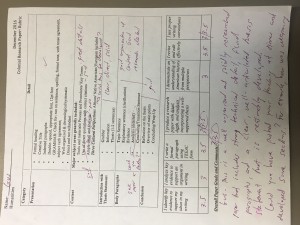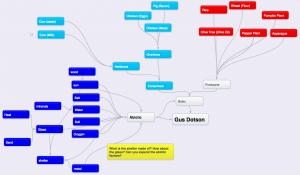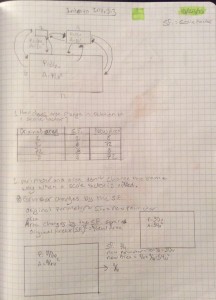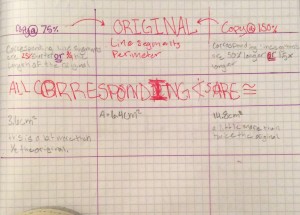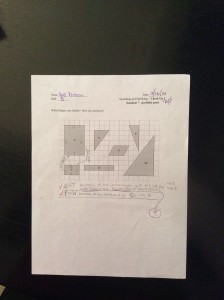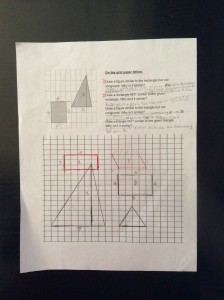Colonial Research Paper
Here are the comments I got on this paper via my teacher Matthew Rosen:
Here is the Essay:
They Are Everywhere:
Weapons in Colonial America
Gus Dotson Colonial Research Paper
Humanities 2016
They owned them, they used them, and they needed them to survive. Weapons were the only hope for the colonists in early America. Each of the three cultures, the Africans, the Native Americans and the English, had different weapons fitted to their purpose. The English had their muskets and heavy artillery, the Native Americans had their bows and tomahawks, and the Africans had their knives and axes. Without weapons the Jamestown colonists would not have survived. They were important to all classes because there was a weapon for every task and a weapon for every colonist from the gentry to the enslaved.
Heavy artillery was important to English and European battles because it would weaken an enemy’s fort or base and would terrify soldiers fighting for the other side. “Although the cannon would fire at a platoon, it wasn’t the best for killing many men at once, so it was actually used mainly to scare the other side because it would kill maybe two people but, while killing them, their guts would spray everywhere, plus once you saw those two get hit, you knew you might be next. Even if you didn’t get hit, it still gave you even more incentive to run.” (Historical Interpreter, Yorktown Battlefield) This explanation highlights that, while the heavy artillery was good for damaging forts, it was often used to make the other side’s troops unsteady and ready to run. The most terrifying aspects of artillery fire were its extraordinarily loud sound, and the charges traveling at high speeds that would shred human flesh when they made impact.
Cannons were used by soldiers and colonists and had many different uses in the battles of Colonial America. For example, field cannons were used sometimes just to scare the other troops by sending a large ball at a high speed directly toward the other platoons, or they would use grapeshot (essentially a round of giant buck shot) to take out large groups of troops from a short range. English and Colonial American soldiers would use garrison cannons from within ships or forts to damage opposing structures and to destroy opposing artillery. “Field Cannon -flat trajectory, Elevating screw raises barrel. Large wheels give mobility on battlefield… Garrison Cannon -flat trajectory, Elevation wedge raises barrel. Small cast iron wheels give limited mobility in fort. Ships carriage has wooden wheels…” (The Colonial Soldier, C. Keith Wilbur). This operational manual excerpt shows that even though they are both cannons, the garrison was used as more of a counter, which was important if the other side was coming with a mortar (which launched an exploding projectile at a high trajectory) or Howitzer (similar to the mortar, but sent its projectile on a longer distance). Field cannons were used to really damage the other side and get into the fight, which made them a key element of military strategy. Cannons were a large type of artillery because they cover a range of uses but there are a few other types of heavy artillery, too.
The Howitzer was very influential in battles that involved a bunker or large base. The reason Howitzers were effective in battles with a base, bunker, or fort, is because they could launch an explosive charge at a high and long trajectory into or onto an enemy structure. “Howitzer -high trajectory, Stubby trail gives greater height to projectile. Similar frame to the field cannon, but with shorter barrel and slightly more upward angle…” (The Colonial Soldier, C. Keith Wilbur). This reference shows that the Howitzer was good for damaging forts and bunkers because it was easily moved, so it could be brought into the battlefield. Its shorter, angled barrel launched an explosive charge high and far that would reach over walls and other blockades that would then then explode and damage people and the fort. Along with Howitzers, the mortar shot an explosive charge.
The mortar was most useful in battle when one force got close to the opposing side’s fort or bunker because the mortar had a very high trajectory but a short range. These features are what made the mortar good for its job. “Mortar -high trajectory, elevating wedge raises barrel. wooden bed is without wheels but easily carried. Mortar was used once close to the enemy fort or bunker…” (The Colonial Soldier, C. Keith Wilbur). This description of a mortar shows that the mortar had the perfect build and was used mainly for a stretch of the battle toward the end, when one side was closer to the other’s bunker or fort. While the artillery was important, it was mainly used by the Europeans; weapons like the tomahawk and bows and arrows were used in battle by the Native Americans.
The tomahawk was the most honorable way a kill a person in the Native American culture. “It was honorable to kill a person with a tomahawk because you had to look them in the eyes and test your strength against theirs.” (Powhatan Interpreter, Recreated Jamestown) This interview excerpt shows that the tomahawk required skill and strength to use it successfully. The tomahawk was not always the most practical way to kill the enemy, so the Powhatans and other tribes would also use bows and arrows while in battle to kill and wound many of the opposing force’s troops, and then go in for a tomahawk charge. The European equivalent to this weapon was the bayonet because once the opposing force was thinned by musket fire, the European soldiers would do a bayonet charge. Although the technologies were quite different, the battle tactics were quite similar. The native battles were short, whereas the European battles were quite long and sometimes lasted hours and hours. Slaves were rarely natives but the most common slave were black and their weapons were knives and axes. The only time slaves would use these weapons when they were either trying to run away or because their master wanted them to protect the plantation. While the Natives had their bows and tomahawks and the enslaved had their knives and axes, the English had their muskets and bayonets.
The musket was the main military long-barreled gun used by the Europeans and English. The musket was good for military use because it had more accuracy than a carbine (a very short musket) or a pistol, but was faster to load than a rifle. To be specific, it took three minutes to load a rifle when it took only 20 seconds to load a musket. Therefore, a musketeer could fire 3 shots in a minute, when a rifleman could not even fire one. Also, the musket was very good for close-quarters combat because it was heavy, which made it a very useful club because a soldier could get more momentum behind it than something that was light. Another asset of the musket was that it could take a bayonet, which was like a type of triangular knife that was only sharp on the very point. The bayonet would attach to the end of the musket and turn it into a spear to fend off an enemy charge by foot or by horseback. “The principal weapon in the Revolution was the smoothbore musket. The interior of the barrel was ungrooved, like that of a modern shotgun. It was also ideal because it only took 20 seconds to load, which was as fast as any muzzle loaded gun could be loaded…The bayonet was used to make a gun that had already been fired into a spear to fight off an enemy charge.” (Interview, Soldier Interpreter) This passage shows that the musket was really the ideal military long barreled gun and useful in almost all circumstances. Although small in size, the bayonet was quite important because without it the soldiers would have needed multiple large and unwieldy weapons at hand at once. But, with a bayonet, it was all in one piece and, unlike a spear or sword, didn’t require much attention during a battle. The primary drawback of the musket was its limited accuracy; therefore, the rifle was principally used for sharp shooting and hunting.
The rifle was not used extensively by the military, other than the sharp-shooters. Its biggest limitations were the three minutes it took to load and it’s light weight which made it bad for close-quarters fighting. Additionally it couldn’t take a bayonet, which meant that you couldn’t aggressively fend off a charge. But it was quite useful in shooting competitions, for snipers, and for hunters because in these positions accuracy mattered more than speed. “Rifles were not used by the military except when a marksman was used to slowly pick off the highest ranked officials on the field, because the rifle was too slow for formation fighting and couldn’t take a bayonet to stop a cavalry charge.” (Gunsmith, Colonial Williamsburg) This quote shows that although the rifle was used on rare occasions, the musket was still the best gun to be used in battle. Rifles were also highly customized so each caliber (which indicates the amount of powder and size of shot used to fire a bullet) was a bit different. As a result, soldiers couldn’t share ammunition when they ran out. While the rifle frequently had limited impact on the battle, muskets and heavy artillery were still more important. The range of choices was also important.
If the settlers hadn’t had superior weapons when they came to the new world, America might not have developed the way it did and might have ended up like the the Roanoke Colony, more commonly known as “The Lost Colony.” Even though the colonies weren’t always at war, weapons could also help them hunt, and many of the Native American tomahawks were also used for farming and building. And slaves used their tools for farming, and as weapons when needed. Weapons were so important during the colonial age that the founding fathers of the United States included the second amendment of the constitution which protects “…The right of the people to keep and bear Arms.” Although there are significant differences between our current society and the colonial period, this second amendment right, and what it means to different people, continues to affect the political debates across our country, including our recent presidential election.
